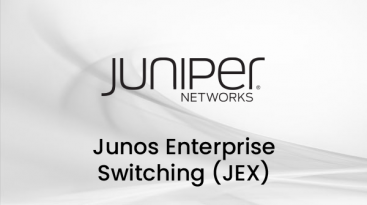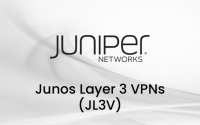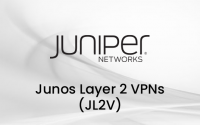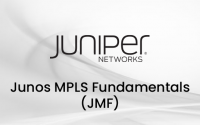Overview
This course is designed to provide students with intermediate switching knowledge and configuration examples using Junos Enhanced Layer 2 Software. This course includes an overview of switching concepts and operations, virtual LANs (VLANs), the Spanning Tree Protocol (STP), port and device security features, and high availability (HA) features.
Duration 2 days.
You can find current trainings on training calendar page.
Training Prerequisites
- Basic networking knowledge and an understanding of the Open Systems Interconnection (OSI) reference model and the TCP/IP protocol suite
- Attend the Introduction to the Junos Operating System (IJOS) course prior to attending this class
Training Contents
Course Introduction
Layer 2 Switching
- Ethernet Bridging Basics
- Terminology and Design Considerations
- Overview of Enterprise Switching Platforms
- Enabling and Monitoring Layer 2 Switching Operations
- EZSetup
- Junos Space Network Director Overview
- Junos Space Network Director Device Discovery
Virtual Networks
- Overview of VLANs
- Configuring and Monitoring VLANs
- Configuring and Deploying Network Director VLAN and Port Profiles
- Voice VLAN
- Native VLAN
- Routed VLAN Interfaces
Spanning Tree
- Spanning Tree Protocol
- Rapid Spanning Tree Protocol
- Configuring and Monitoring STP and RSTP
- Troubleshooting STP and RSTP
- Protection Features: BPDU Protection
- Protection Features: Loop Protection
- Protection Features: Root Protection
Port Security
- MAC Limiting
- Persistent MAC Learning
- DHCP Snooping
- Dynamic ARP Inspection (DAI)
- IP Source Guard
- MACsec
Device Security and Firewall Filters
- Storm Control
- Firewall Filters
Virtual Chassis
- Overview of Virtual Chassis
- Configuring and Monitoring a Virtual Chassis
High Availability Features
- Overview of High Availability Networks
- Link Aggregation Groups
- Redundant Trunk Groups
- Graceful Routing Engine Switchover (GRES)
- Nonstop Active Routing (NSR)
- Nonstop Bridging (NSB)
Training Objectives
- List the benefits of implementing switched LANs.
- Describe transparent bridging concepts and operations.
- Describe terms and design considerations for switched LANs.
- List enterprise platforms that support Layer 2 switching.
- Configure interfaces for Layer 2 switching operations.
- Display and interpret the Ethernet switching table.
- Explain the concept of a VLAN.
- Describe access and trunk port modes.
- Configure and monitor VLANs.
- Describe voice VLAN and native VLAN concepts.
- Explain inter-VLAN routing operations.
- Configure and monitor inter-VLAN routing.
- Explain when a spanning tree is required.
- Describe STP and Rapid Spanning Tree Protocol (RSTP) operations.
- List some advantages of using RSTP over STP.
- Configure and monitor RSTP.
- Describe the bridge protocol data unit (BPDU), loop, and root protection features.
- Configure and monitor the BPDU, loop, and root protection features.
- List and describe various port security features.
- Configure and monitor port security features.
- Describe the storm control feature.
- Configure and monitor storm control.
- Describe firewall filter support for EX Series Ethernet Switches.
- Implement and monitor the effects of a firewall filter.
- List and describe some features that promote high availability.
- Configure and monitor high availability features.
- Describe the basic concepts and operational details of a virtual chassis.
- Implement a virtual chassis with multiple EX4300 switches.
- Explain the concepts of Ethernet Ring Protection Switching (ERPS).
- Configure and monitor ERPS.
- Explain the concepts of Multiple Spanning Tree Protocol (MSTP).
- Configure and monitor MSTP.
- Discover, configure, and troubleshoot EX Series switches using Junos Space Network Director.
Who should attend?
This course benefits individuals responsible for configuring and monitoring EX Series switches running Junos ELS.
- Overview
- Prerequisites
- Contents
- Objectives
- Audience
Overview
This course is designed to provide students with intermediate switching knowledge and configuration examples using Junos Enhanced Layer 2 Software. This course includes an overview of switching concepts and operations, virtual LANs (VLANs), the Spanning Tree Protocol (STP), port and device security features, and high availability (HA) features.
Duration 2 days.
You can find current trainings on training calendar page.
Training Prerequisites
- Basic networking knowledge and an understanding of the Open Systems Interconnection (OSI) reference model and the TCP/IP protocol suite
- Attend the Introduction to the Junos Operating System (IJOS) course prior to attending this class
Training Contents
Course Introduction
Layer 2 Switching
- Ethernet Bridging Basics
- Terminology and Design Considerations
- Overview of Enterprise Switching Platforms
- Enabling and Monitoring Layer 2 Switching Operations
- EZSetup
- Junos Space Network Director Overview
- Junos Space Network Director Device Discovery
Virtual Networks
- Overview of VLANs
- Configuring and Monitoring VLANs
- Configuring and Deploying Network Director VLAN and Port Profiles
- Voice VLAN
- Native VLAN
- Routed VLAN Interfaces
Spanning Tree
- Spanning Tree Protocol
- Rapid Spanning Tree Protocol
- Configuring and Monitoring STP and RSTP
- Troubleshooting STP and RSTP
- Protection Features: BPDU Protection
- Protection Features: Loop Protection
- Protection Features: Root Protection
Port Security
- MAC Limiting
- Persistent MAC Learning
- DHCP Snooping
- Dynamic ARP Inspection (DAI)
- IP Source Guard
- MACsec
Device Security and Firewall Filters
- Storm Control
- Firewall Filters
Virtual Chassis
- Overview of Virtual Chassis
- Configuring and Monitoring a Virtual Chassis
High Availability Features
- Overview of High Availability Networks
- Link Aggregation Groups
- Redundant Trunk Groups
- Graceful Routing Engine Switchover (GRES)
- Nonstop Active Routing (NSR)
- Nonstop Bridging (NSB)
Training Objectives
- List the benefits of implementing switched LANs.
- Describe transparent bridging concepts and operations.
- Describe terms and design considerations for switched LANs.
- List enterprise platforms that support Layer 2 switching.
- Configure interfaces for Layer 2 switching operations.
- Display and interpret the Ethernet switching table.
- Explain the concept of a VLAN.
- Describe access and trunk port modes.
- Configure and monitor VLANs.
- Describe voice VLAN and native VLAN concepts.
- Explain inter-VLAN routing operations.
- Configure and monitor inter-VLAN routing.
- Explain when a spanning tree is required.
- Describe STP and Rapid Spanning Tree Protocol (RSTP) operations.
- List some advantages of using RSTP over STP.
- Configure and monitor RSTP.
- Describe the bridge protocol data unit (BPDU), loop, and root protection features.
- Configure and monitor the BPDU, loop, and root protection features.
- List and describe various port security features.
- Configure and monitor port security features.
- Describe the storm control feature.
- Configure and monitor storm control.
- Describe firewall filter support for EX Series Ethernet Switches.
- Implement and monitor the effects of a firewall filter.
- List and describe some features that promote high availability.
- Configure and monitor high availability features.
- Describe the basic concepts and operational details of a virtual chassis.
- Implement a virtual chassis with multiple EX4300 switches.
- Explain the concepts of Ethernet Ring Protection Switching (ERPS).
- Configure and monitor ERPS.
- Explain the concepts of Multiple Spanning Tree Protocol (MSTP).
- Configure and monitor MSTP.
- Discover, configure, and troubleshoot EX Series switches using Junos Space Network Director.
Who should attend?
This course benefits individuals responsible for configuring and monitoring EX Series switches running Junos ELS.






